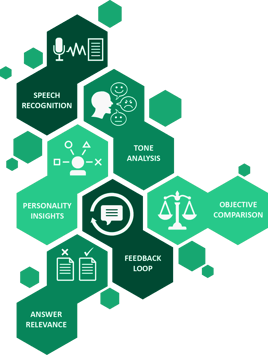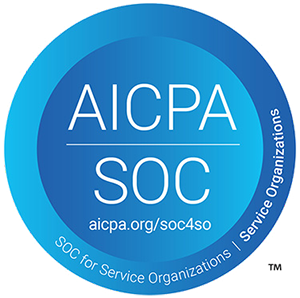Talent Acquisition is the key to building a strong team - the right talent can make or break the company. Hence the process of Talent Acquisition is key to an establishment seeking high levels of performance and efficiency.
The real challenge lies in choosing talent that is holistically akin to the ethos of the firm and has the capability to meet the growth promises and challenges.
Additionally, the various administrative steps that entail the process makes the task of finding talent tedious and cumbersome. However, the digital age offers an effective solution to overcome these challenges with the manifestation of Artificial Intelligence that has the ability to quickly analyze data, make predictions and churn out decisions.
Can Artificial Intelligence Transform Your Hiring Process?
AI plays a multi-faceted role. It has the ability assess the nature of a job description, conduct objective comparison tests, maintain a
 highly responsive feedback loop, measure quantitative and qualitative capacities of an individual to fill a job role and perform various other functions that optimize the talent seeking process. Looking into the potential of AI in this area means answering certain pertinent questions.
highly responsive feedback loop, measure quantitative and qualitative capacities of an individual to fill a job role and perform various other functions that optimize the talent seeking process. Looking into the potential of AI in this area means answering certain pertinent questions.
Let us discuss some of the most promising use cases of AI in hiring in order to assess the impact of technology can have in the field of Talent Acquisition.
-
Survival analysis

How long will it take to fill a role?
AI can use data on job positions filled in the past, the time frame it took to fill them, the number of candidates, open positions and companies, specific market data, etc. to calculate the ‘survival rate' of available jobs. The results tabulated by AI allow the recruitment team to set reasonable expectations for hiring managers and allocate appropriate resources to harder-to-fill roles. -
All Look Similar
Is the candidate a good fit to the company requirements and work culture?
This question does not translate into a traditional Boolean search. What the recruiter is looking for is a candidate with the right skill-set, experience, culture fit, soft skills, interest in the job, is hailing from a specific geographical location and the cost to the company.
What the recruiter is looking for is a candidate with the right skill-set, experience, culture fit, soft skills, interest in the job, is hailing from a specific geographical location and the cost to the company.With many candidates applying the recruiter is spoilt for choice and finds it difficult to come to a concrete decision. Employing contextual searches that understand the intent of the search, one can improve the relevance of the search and obtain the best results through AI.
-
No Response
How do you address the problem of missing out on good candidates due to lack of responsiveness and time constraints?
Responsiveness is of utmost importance, especially when candidates spend hours filling out a job application and writing their cover letters. It reflects the credibility of the firm and the culture it promotes. Manually responding to the applicants may add hours to the clock and makes the process lengthy and tedious.
applicants may add hours to the clock and makes the process lengthy and tedious.For example, if the candidate has had to wait for two weeks to schedule an interview, traveled miles to attend the interview and then have no way to find out whether they procured the job or not cuts a sorry figure of the company, making them lose faith in its working. An easy and effect AI solution would be ‘chatbots’ – that can screen candidate applications for the essential criteria in a matter of minutes, provide updates to the candidates at every stage of the selection process and also gamify the entire experience.
-
Lack of Predictability

How do we address the question of maintaining objectivity?
Most hiring managers understand only domain skill fitment and are not trained to look for cognitive or behavioral fitment. Traditional MCQ type assessments are one-dimensional and easier to trick. With the advent of Computer Vision and NLP technologies, one can analyze speech, facial expressions, and voice tremors to build profiling that can aid hiring managers in their evaluation. Extension of same to systems to build self-learning models for on job performance prediction, attrition, etc. widen the scope of AI’s reach. -
Triple Constraints
How do I hire the best available candidate?
Hiring is a multi-objective problem that aims to maintain quality keeping in mind constraints of time and cost. However, multi-objective optimization in decision-making is not a task that comes quickly to humans. But by comparing candidates using Pareto Optimization model you can narrow down the list to find the best hire within the available set of candidates. It is quintessential to keep in mind that no placements are better than inappropriate or bad placements.
Talview’s ethos aims at delivering services that are based on state-of-the-art research and have been proven to produce results in real-time situations. Deriving inspiration from the practical applicability and optimization potential of AI, Talview has woven an AI-centric approach to the Talent Acquisition Process. A closer look into certain case-studies undertaken at Talview would provide a clearer picture:
Case I: Graduate Hiring
The process of graduate hiring involves receiving a large number of applications with no effective way to screen candidates for behavioral temperament, learning ability, and communication skills. These were the same challenges a leading global consulting company was facing during its graduate hiring drive.
Talview was able to work around the problem by employing digital interviews with AI-based multi-dimensional profiling to create a stacked order list of candidates eligible for the final interview.
This exercise helped save 80% panel time on campus and reduced the effort per hire by 55% and streamlined and standardized the hiring process. This was the first time automation technology was being used in hiring with the help of NLP, video interview, psycholinguistics, tone analysis and emotion recognition to build a candidate’s behavioral profile from their natural speech during the interview
Talview Behavioural Insights
The exercise was based on well-established and industry-accepted models like Big 5 and Intrinsic Needs and Values which were enhanced with tone analysis and emotion recognition. Big 5 has been in existence for more than four decades as a significant research and application tool in assessment for professional performance and relationships. Psycholinguistics was employed to derive attribute scores from natural language which was later calibrated for specific use-case leveraging.
The exercise was conducted under the guidance of experts from academia and industry to measure the effectiveness and their testimonies are proof of the validity and credibility of the study.
Some of the key advantages of the study have been listed below:
-
Fewer steps: TBI report is generated from a video interview and eliminates the need for behavioral assessment

-
Fake-proof: Answers given by the candidate to questions during their routine interview process, cannot be tricked and are more accurate
-
Learning capabilities: Self-calibration of the reporting to suit the requirement of client organization and covers the needs of specific teams
-
Simple reports: Easy-to-read, job contextualized and customizable reports developed by leading occupational psychologists under the guidance of industry experts

-
Interview questionnaire and development guide: Scientifically designed questionnaire and guide available to meet the job profile.
Case II: Lateral Hiring
Lateral hiring brings in seasoned talent and experience into your firm. But recruiters are often bogged down by long lead times, large volumes of potential candidates to sort through and setting up interviews with candidates from different time zones. A global IT services company faced the same roadblocks when they wanted to recruit laterally.
The solutions charted out by the Talview team provided an AI-based video-proctoring assessment for screening, digital video profiling for in-depth analysis and live video Interviews with shortlisted candidates/panels globally.
The benefits gained by the client included a ~60% saving in panel time, a ~30% reduction in Time to Offer and helped in streamline the process to ensure complete transparency.
Intelligent Proctoring
Advanced automated proctoring tools monitor the candidate’s audio-visual feed for any suspicious activities using advanced audio and visual analytics. Some key features of Talview’s Intelligent Proctoring include -
-
Complete audio and video recording of the interview

-
Auto trigger on candidate actions, tracking browser switches and blocking copy-paste options to prevent cheating
-
Validation of candidate based on face and voice recognition across various online assessment rounds and interviews
-
Restricting test access and geo-tagging and randomised questions to keep a check on cheating
Case III: Lateral Hiring (leveraging past performance data)
A large private sector bank was facing two major types of issues during its lateral hiring process while trying to leverage its past performance data -
-
Role descriptions and hiring methodology weren’t aligned
-
There was a high proportion of poor performing hires
With the help of AI, Talview helped the bank profile existing relationship managers using standardized assessments, build predictive models based on performance history and institute a new hire profile selection based on performance prediction.
The dividends gained included a ~85% accuracy in prediction of performance, an 80% higher performance record and a 60% better Candidate Experience feedback. The whole exercise helped the client in securing the Asian Banker Technology Innovation Award.
Talent Assistant Chatbot
The Talent Assistant Chatbot helps streamline the Talent Acquisition process in the following ways:
-
Auto-responds to the incoming queries and applications across candidate engagement channels

-
Bot screens the candidate applications asking basic questions and reviewing them for the essential criteria for candidates within no time
-
Reduces the possibility of unconscious bias from the recruiter in early stages of the screening process
-
Bot can be used across channels – including social media outlets, to answer candidate queries and create tickets
-
The widget can be embedded on web pages like career portals and career pages in client websites.
Talview Talent Quadrant
 Talent Quadrant is a multi-objective decision-making tool that helps clients in comparing candidates across multiple parameters in a single view. It takes into consideration multiple objectives like Behavioural Fitment, Technical Competency, Cognitive Capabilities, Cost and Time to Join to plot the candidate points on an interactive graph. While offering four color-gradient quadrants with easy to understand terminologies, it accurately plots the candidates based on their performance making it extremely objective and devoid of bias.
Talent Quadrant is a multi-objective decision-making tool that helps clients in comparing candidates across multiple parameters in a single view. It takes into consideration multiple objectives like Behavioural Fitment, Technical Competency, Cognitive Capabilities, Cost and Time to Join to plot the candidate points on an interactive graph. While offering four color-gradient quadrants with easy to understand terminologies, it accurately plots the candidates based on their performance making it extremely objective and devoid of bias.
The Talview experience of AI in Talent Acquisition ensures that the two key stakeholders – employer and applicant are satisfied with the process. The client (employer) is able to optimize their process of talent hunt with minimal wastage of resources. The gamification of the process enhances the candidate experience and creates faith in the selection process. Thus the credibility of the system is validated and the best talent is allocated to the position in question. A clichéd quote reads that the goal of a recruiter is to get the right people on the bus; then removing the wrong people off the bus and then getting the right people in the right seats. With AI entering the scene and Talview’s expertise, we are closer towards achieving the recruiter’s goal.








Leave a Reply